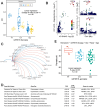Single cell transcriptomes and multiscale networks from persons with and without Alzheimer's disease
- PMID: 38987616
- PMCID: PMC11237088
- DOI: 10.1038/s41467-024-49790-0
Single cell transcriptomes and multiscale networks from persons with and without Alzheimer's disease
Abstract
The emergence of single nucleus RNA sequencing (snRNA-seq) offers to revolutionize the study of Alzheimer's disease (AD). Integration with complementary multiomics data such as genetics, proteomics and clinical data provides powerful opportunities to link cell subpopulations and molecular networks with a broader disease-relevant context. We report snRNA-seq profiles from superior frontal gyrus samples from 101 well characterized subjects from the Banner Brain and Body Donation Program in combination with whole genome sequences. We report findings that link common AD risk variants with CR1 expression in oligodendrocytes as well as alterations in hematological parameters. We observed an AD-associated CD83(+) microglial subtype with unique molecular networks and which is associated with immunoglobulin IgG4 production in the transverse colon. Our major observations were replicated in two additional, independent snRNA-seq data sets. These findings illustrate the power of multi-tissue molecular profiling to contextualize snRNA-seq brain transcriptomics and reveal disease biology.
© 2024. The Author(s).
Conflict of interest statement
The authors declare no competing interests.
Figures




Update of
-
A public resource of single cell transcriptomes and multiscale networks from persons with and without Alzheimer's disease.bioRxiv [Preprint]. 2023 Oct 24:2023.10.20.563319. doi: 10.1101/2023.10.20.563319. bioRxiv. 2023. Update in: Nat Commun. 2024 Jul 10;15(1):5815. doi: 10.1038/s41467-024-49790-0. PMID: 37961404 Free PMC article. Updated. Preprint.
References
-
- Zhang, L. et al. Single-cell transcriptomic atlas of Alzheimer’s disease middle temporal gyrus reveals region, cell type and sex specificity of gene expression with novel genetic risk for MERTK in female. medRxiv10.1101/2023.02.18.23286037 (2023).
MeSH terms
Substances
Grants and funding
- P30 AG072975/AG/NIA NIH HHS/United States
- U01 AG046152/AG/NIA NIH HHS/United States
- U01 AG061835/AG/NIA NIH HHS/United States
- U01 AG061356/AG/NIA NIH HHS/United States
- U01AG061835/U.S. Department of Health & Human Services | NIH | National Institute on Aging (U.S. National Institute on Aging)
- R21 AG063068/AG/NIA NIH HHS/United States
- P30 AG010161/AG/NIA NIH HHS/United States
- U01 AG046139/AG/NIA NIH HHS/United States
- P30 AG019610/AG/NIA NIH HHS/United States
- R21AG063068/U.S. Department of Health & Human Services | NIH | National Institute on Aging (U.S. National Institute on Aging)
- R01 AG015819/AG/NIA NIH HHS/United States
- R01 AG017917/AG/NIA NIH HHS/United States
- P30 AG072980/AG/NIA NIH HHS/United States
- R01 AG062514/AG/NIA NIH HHS/United States
- U24 NS072026/NS/NINDS NIH HHS/United States
LinkOut - more resources
Full Text Sources
Medical

